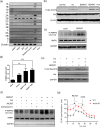Inhibition of serotonin-Htr2b signaling in skeletal muscle mitigates obesity-induced insulin resistance
- PMID: 40451926
- PMCID: PMC12227683
- DOI: 10.1038/s12276-025-01460-x
Inhibition of serotonin-Htr2b signaling in skeletal muscle mitigates obesity-induced insulin resistance
Erratum in
-
Author Correction: Inhibition of serotonin-Htr2b signaling in skeletal muscle mitigates obesity-induced insulin resistance.Exp Mol Med. 2025 Jun;57(6):1350-1352. doi: 10.1038/s12276-025-01492-3. Exp Mol Med. 2025. PMID: 40588531 Free PMC article. No abstract available.
Abstract
Obesity-induced insulin resistance is a major cause of metabolic disorders, including type 2 diabetes mellitus. Although peripheral serotonin (5-hydroxytryptamine, 5-HT) has been implicated in energy balance and metabolism, its effect on skeletal muscle insulin sensitivity remains unclear. Here we identified the 5-HT receptor 2b (Htr2b) as a critical regulator of insulin sensitivity and energy metabolism in the skeletal muscle. Using genetic and pharmacological approaches, we showed that muscle-specific Tph1-knockout (Tph1 MKO) mice fed a high-fat diet exhibited reduced body weight, increased lean mass and improved glucose tolerance compared with wild-type mice. The pharmacological inhibition of Htr2b in myotubes reversed palmitate-induced insulin resistance and increased glycolytic activity. Moreover, muscle-specific HTR2b-knockout (HTR2b MKO) mice exhibited improved glucose uptake, insulin sensitivity and overall metabolic health under high-fat-diet-induced obesity. Mechanistically, both Tph1 MKO and Htr2b MKO mice showed increased phosphorylation of AKT and AMPK, indicating improved insulin sensitivity and energy metabolism in the skeletal muscle. These findings demonstrate that 5-HT-Htr2b signaling negatively regulates insulin sensitivity and energy metabolism in skeletal muscles, providing new insights into the role of peripheral serotonin in muscle metabolism and potential therapeutic targets for metabolic disorders.
© 2025. The Author(s).
Conflict of interest statement
Competing interests: The authors declare no competing interests.
Figures






References
MeSH terms
Substances
Grants and funding
- RS-2024-00440824/National Research Foundation of Korea (NRF)
- RS-2021-NR061302/National Research Foundation of Korea (NRF)
- RS-2023-00222910/National Research Foundation of Korea (NRF)
- RS-2024-00406568/National Research Foundation of Korea (NRF)
- 2022R1A5A2018865/National Research Foundation of Korea (NRF)
LinkOut - more resources
Full Text Sources
Medical

